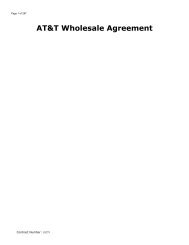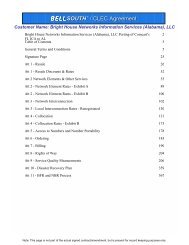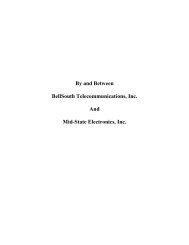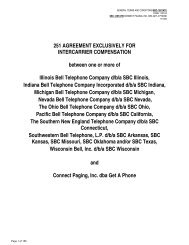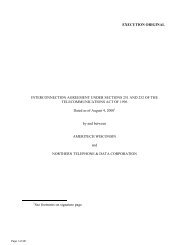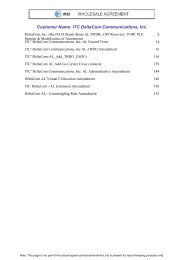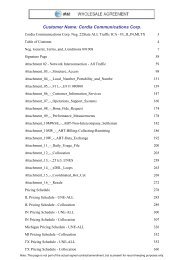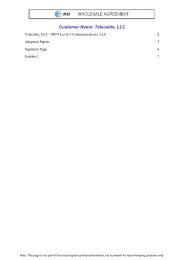AT&T Wholesale Agreement - AT&T Clec Online
AT&T Wholesale Agreement - AT&T Clec Online
AT&T Wholesale Agreement - AT&T Clec Online
Create successful ePaper yourself
Turn your PDF publications into a flip-book with our unique Google optimized e-Paper software.
Page 85 of 94<br />
Attachment 05 – 911/E911/AT&T LOUISIANA<br />
Page 4 of 8<br />
Cricket Communications, Inc.<br />
Version: 3Q08 – Two-Way CMRS ICA – Wireless 02/12/09<br />
2.13 “Database Management System” or “DBMS” means a system of manual procedures and computer programs used to<br />
create, store and update the data required to provide Selective Routing and/or ALI for 911 systems.<br />
2.14 “E911 Authority” means a municipality or other State or Local government unit, or an authorized agent of one or more<br />
municipalities or other State or Local government units to whom authority has been lawfully designated as the<br />
administrative entity to manage a public emergency telephone system for emergency police, fire, and emergency<br />
medical services through the use of one telephone number, 911.<br />
2.15 “E911 Service” means the functionality to route wireless 911 calls and the associated caller and/or location data of<br />
the wireless end user to the appropriate Public Safety Answering Point.<br />
2.16 “E911 Trunk” means one-way terminating circuits which provide a trunk-side connection between WSP's MSC and<br />
AT&T LOUISIANA 911 Tandem equipped to provide access to 911 services as technically defined in Telcordia<br />
Technical Reference GR145-CORE.<br />
2.17 “E911 Universal Emergency Number Service” (also referred to as “Expanded 911 Service” or “Enhanced 911<br />
Service”) or “E911 Service” means a telephone exchange communications service whereby a PSAP answers<br />
telephone calls placed by dialing the number 911. E911 includes the service provided by the lines and equipment<br />
associated with the service arrangement for the answering, transferring, and dispatching of public emergency<br />
telephone calls dialed to 911. E911 provides completion of a call to 911 via dedicated trunks and includes ANI, ALI,<br />
and/or Selective Routing.<br />
2.18 “Emergency Service Number” or “ESN” is a three to five digit number representing a unique combination of<br />
emergency service agencies (Law Enforcement, Fire, and Emergency Medical Service) designated to serve a<br />
specific range of addresses within a particular geographical area, or Emergency Service Zone (ESZ). The ESN<br />
facilitates selective routing and selective transfer, if required, to the appropriate PSAP and the dispatching of the<br />
proper service agency(ies).<br />
2.19 “Emergency Services” means police, fire, ambulance, rescue, and medical services.<br />
2.20 “Emergency Service Routing Digits” or “ESRD” is a digit string that uniquely identifies a base station, Cell Site, or<br />
sector that may be used to route emergency calls through the network in other than an NCAS environment.<br />
2.21 “Emergency Service Routing Key” or “ESRK” is a 10 digit routable, but not necessarily dialable, number that is used<br />
not only for routing but also as a correlator, or key, for the mating of data that is provided to the PSAP (a.k.a. 911<br />
Center) by different paths, such as via the voice path and ALI data path in an NCAS environment.<br />
2.22 “End User”, for purposes of this Attachment only, means the 911 caller.<br />
2.23 “Hybrid CAS” means a wireless 911 solution set that utilizes one transmission path to deliver the voice and Mobile<br />
Directory Number (MDN) to the PSAP and a separate transmission path to deliver the callers location information to<br />
the PSAP.<br />
2.24 “Meet Point” means the demarcation between the AT&T LOUISIANA network and the WSP network.<br />
2.25 “Mobile Directory Number” or “MDN” means a 10-digit dialable directory number used to call a Wireless Handset.<br />
2.26 “Mobile Identification Number” or “MIN” means a 10-digit number assigned to and stored in a Wireless Handset.<br />
2.27 “NENA Company Identifier” or “NENA ID” means the three to five (3 to 5) character identifier obtained by the<br />
Customer from the National Emergency Number Association (NENA), 4350 N. Fairfax Drive, Suite 750, Arlington,<br />
VA 22203-1695. The NENA company ID allows the PSAP to identify the switching carrier for the caller, and to<br />
determine the 24 x 7 number of the Company for emergency contact needs.<br />
2.28 “Non-Call path Associated Signaling” or “NCAS” means a wireless 9-1-1 solution set that utilizes one transmission<br />
path to deliver the voice and a separate transmission path to deliver the Mobile Directory Number and the caller’s<br />
location to the PSAP.<br />
2.29 “Phase I” - as defined in CC Docket 94-102. Phase I data includes the Call Back Number and the associated 911<br />
ALI.<br />
2.30 “Phase II” - as defined in CC Docket 94-102. Phase II data includes XY coordinates, confidence factor and certainty.<br />
2.31 “Public Safety Answering Point” or “PSAP” means an answering location for 911 calls originating in a given area.<br />
The E911 Authority may designate a PSAP as primary or secondary, which refers to the order in which calls are<br />
directed for answering. Primary PSAPs answer calls; secondary PSAPs receive calls on a transfer basis. PSAPs<br />
Page 85 of 105



